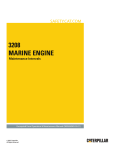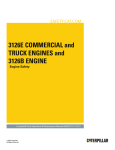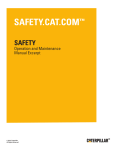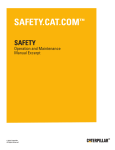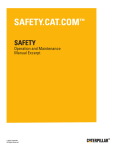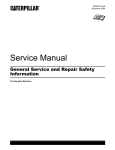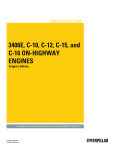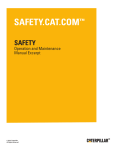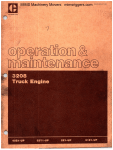Download 3208 MARINE ENGINE - Safety
Transcript
SAFETY.CAT.COM 3208 MARINE ENGINE Engine Safety Excerpted from Operation & Maintenance Manual (SEBU6090-03-01) © 2007 Caterpillar All Rights Reserved i00056692 Important Safety Information Most accidents that involve product operation, maintenance and repair are caused by failure to observe basic safety rules or precautions. An accident can often be avoided by recognizing potentially hazardous situations before an accident occurs. A person must be alert to potential hazards. This person should also have the necessary training, skills and tools to perform these functions properly. Improper operation, lubrication, maintenance or repair of this product can be dangerous and could result in injury or death. Do not operate or perform any lubrication, maintenance or repair on this product, until you have read and understood the operation, lubrication, maintenance and repair information. Safety precautions and warnings are provided in this manual and on the product. If these hazard warnings are not heeded, bodily injury or death could occur to you or to other persons. The hazards are identified by the “Safety Alert Symbol” and followed by a “Signal Word” such as “WARNING” as shown below. The meaning of this safety alert symbol is as follows: Attention! Become Alert! Your Safety is Involved. The message that appears under the warning explains the hazard and can be either written or pictorially presented. Operations that may cause product damage are identified by “NOTICE” labels on the product and in this publication. Caterpillar cannot anticipate every possible circumstance that might involve a potential hazard. The warnings in this publication and on the product are, therefore, not all inclusive. If a tool, procedure, work method or operating technique that is not specifically recommended by Caterpillar is used, you must satisfy yourself that it is safe for you and for others. You should also ensure that the product will not be damaged or be made unsafe by the operation, lubrication, maintenance or repair procedures that you choose. The information, specifications, and illustrations in this publication are on the basis of information that was available at the time that the publication was written. The specifications, torques, pressures, measurements, adjustments, illustrations, and other items can change at any time. These changes can affect the service that is given to the product. Obtain the complete and most current information before you start any job. Caterpillar dealers have the most current information available. For a list of the most current publication form numbers available, see the Service Manual Contents Microfiche, REG1139F. 6 Safety Section Warning Signs and Labels Safety Section Battery i00890538 Warning Signs and Labels SMCS Code: 1000; 7405 There may be several specific warning signs on an engine. The exact location of the hazards and the description of the hazards are reviewed in this section. Please become familiar with all warning signs. Ensure that all of the warning signs are legible. Clean the warning signs or replace the warning signs if the words cannot be read or if the pictures are not visible. When the warning signs are cleaned, use a cloth, water, and soap. Do not use solvent, gasoline, or other harsh chemicals to clean the warning signs. Solvents, gasoline, or harsh chemicals could loosen the adhesive that secures the warning signs. The warning signs that are loosened could drop off of the engine. Illustration 1 g00454398 The warning label for the battery should be installed on the side of the engine or in a visible location near the batteries. If the batteries are located on both sides of the package, the warning label should be located on both sides of the engine. Replace any damaged warning signs or missing warning signs. If a warning sign is attached to a part of the engine that is replaced, install a new warning sign on the replacement part. Any Caterpillar dealer can provide new warning signs. Do not operate or work on this engine unless you have read and understand the instructions and warnings in the Operation and Maintenance Manual. Failure to follow the instructions or heed the warnings could result in injury or death. Contact any Caterpillar dealer for replacement manuals. Proper care is your responsibility. The warning labels that may be found on the engine are illustrated and described below. g00455028 Improper jumper cable connections can cause an explosion resulting in personal injury. Batteries may be located in separate compartments. When you are using jump start cables, always connect the positive “+” cable to the positive “+” terminal of the battery that is connected to the starter solenoid. Connect the negative “-” cable from the external source to the negative “-” terminal of the starter. If the engine is not equipped with a negative “-” terminal on the starter, connect the negative “-” cable from the external source to the engine block. Follow the procedure in this Operation and Maintenance Manual. 7 Safety Section General Hazard Information i00947640 General Hazard Information • Wear a hard hat, protective glasses, and other protective equipment, as required. • When work is performed around an engine that is SMCS Code: 1000; 7405 Attach a “Do Not Operate” warning tag or a similar warning tag to the start switch or to the controls before the engine is serviced or before the engine is repaired. These warning tags (Special Instruction, SEHS7332) are available from your Caterpillar dealer. Attach the warning tags to the engine and to each operator control station. When it is appropriate, disconnect the starting controls. operating, wear protective devices for ears in order to help prevent damage to hearing. • Do not wear loose clothing or jewelry that can snag on controls or on other parts of the engine. • Ensure that all protective guards and all covers are secured in place on the engine. • Never put maintenance fluids into glass containers. Glass containers can break. • Use all cleaning solutions with care. • Report all necessary repairs. Unless other instructions are provided, perform the maintenance under the following conditions: • The engine is stopped. • The protective locks or the controls are in the applied position. Illustration 2 g00104545 Do not allow unauthorized personnel on the engine or around the engine when the engine is serviced. Engine exhaust contains products of combustion which may be harmful to your health. Always start the engine and operate the engine in a well ventilated area. If the engine is in an enclosed area, vent the engine exhaust to the outside. Cautiously remove the following parts: • Filler caps • Grease fittings • Pressure taps • Breathers • Drain plugs To help prevent spraying or splashing of pressurized fluids, hold a rag over the part that is being removed. Use caution when cover plates are removed. Gradually loosen but do not remove the last two bolts or nuts that are located at opposite ends of the cover plate or the device. Before removing the last two bolts or nuts, pry the cover loose in order to relieve any spring pressure or other pressure. • Disconnect the batteries when maintenance is performed or when the electrical system is serviced. Disconnect the battery ground leads. Tape the leads in order to help prevent sparks. • Do not attempt any repairs or any adjustments to the engine while the engine is operating. • Do not attempt any repairs that are not understood. Use the proper tools. Replace any equipment that is damaged or repair the equipment. • For initial start-up of a new engine or for starting an engine that has been serviced, make provisions to stop the engine if an overspeed occurs. This may be accomplished by shutting off the fuel supply and/or the air supply to the engine. • Start the engine from the operator’s position or from the control panel that is in the local engine room. Pressurized Air and Water Pressurized air and/or water can cause debris and/or hot water to be blown out. This could result in personal injury. When pressurized air is used for cleaning, wear a protective face shield, protective clothing, and protective shoes. 8 Safety Section General Hazard Information The maximum air pressure for cleaning purposes must be below 205 kPa (30 psi). The maximum water pressure for cleaning purposes must be below 275 kPa (40 psi). Always wear eye protection for cleaning the cooling system. Fluid Penetration Always use a board or cardboard when the engine components are checked for leaks. Leaking fluid that is under pressure can cause serious injury or possible death. This includes leaks that are the size of a pin hole. If fluid is injected into the skin, seek treatment immediately. Seek treatment from a doctor that is familiar with this type of injury. Fluid Spillage Care must be used in order to ensure that the fluids are contained during the inspection, the maintenance, the testing, the adjusting, and the repair of the engine. Make provision to collect the fluid with a suitable container before any compartment is opened or before any component is disassembled. Refer to the Special Publication, NENG2500. This publication explains the items that are needed for collecting and for containing fluids that are used in Caterpillar engines. Dispose of fluids according to local regulations. Asbestos Information Caterpillar equipment and replacement parts that are shipped from Caterpillar are asbestos free. Caterpillar recommends the use of only genuine Caterpillar replacement parts. Use the following guidelines when any replacement parts that contain asbestos or debris that contains asbestos are handled. The asbestos in these components is usually sealed or bonded in a resin. Handling these materials normally is not hazardous unless airborne dust that contains asbestos is generated. Do not inhale dust that might be generated when components that contain asbestos fibers are handled. Inhaling this dust can be hazardous to your health. If dust which may contain asbestos is present, follow these guidelines: • Never use compressed air for cleaning. • Avoid abrasion of materials that contain asbestos. • Use a wet method to clean up asbestos debris. A vacuum cleaner that is equipped with a high efficiency particulate air filter can also be used. • Use exhaust ventilation when parts that contain asbestos are machined. • Wear an approved respirator if there is no other way to control the dust. • Comply with applicable rules and regulations for the work place. In the USA, use the Occupational Safety and Health Administration requirements. These OSHA requirements can be found in “29 CFR 1910.1001”. • Obey environmental regulations for disposal of asbestos. • Stay away from areas that might have asbestos particles in the air. Lines, Tubes, and Hoses Do not bend or strike high pressure lines. Do not install lines, tubes, or hoses that are damaged. Repair any fuel lines, oil lines, tubes, or hoses that are loose or damaged. Leaks can cause fires. Inspect all lines, tubes and hoses carefully. Do not use bare hands to check for leaks. Always use a board or cardboard for checking engine components for leaks. Tighten all connections to the recommended torque. Check for the following conditions: • End fittings that are damaged or leaking • Outer covering that is chafed or cut • Wire that is exposed in reinforced hose • Outer covering that is ballooning locally • Flexible part of the hose that is kinked or crushed • Armoring that is embedded in the outer covering Ensure that all of the clamps, the guards, and the heat shields are installed correctly. This will help to prevent the following items: vibration, rubbing against other parts, and excessive heat during operation. 9 Safety Section Burn Prevention i00910250 Burn Prevention SMCS Code: 1000; 7405 Do not touch any part of an operating engine. Allow the engine to cool before any maintenance is performed on the engine. Relieve all pressure in the lubrication system, in the fuel system, or in the cooling system before any lines, fittings or related items are disconnected. Batteries give off combustible gases which can explode. Ensure proper ventilation for batteries that are in an enclosure. Never disconnect any charging unit circuit or battery circuit cable from the battery when the charging unit is operating. A spark can cause the combustible gases to ignite. Do not smoke when batteries are serviced. Always thaw a frozen battery before jump starting the battery. Frozen batteries can explode. i00061925 Coolant When the engine is at operating temperature, the engine coolant is hot. The coolant is also under pressure. The radiator and all lines to the heaters or to the engine contain hot coolant. When pressure is relieved rapidly, the hot coolant can turn into steam. Any contact with hot coolant or with steam can cause severe burns. Allow cooling system components to cool before the cooling system is drained. Check the coolant level only after the engine has been stopped. Do not step on the engine in order to remove the filler cap. Use a ladder, if necessary. Ensure that the filler cap is cool before removing the filler cap. Remove the filler cap slowly in order to relieve pressure. Cooling system conditioner contains alkali. Alkali can cause personal injury. Do not allow alkali to contact the skin, the eyes, or the mouth. Oils Hot oil and hot components can cause personal injury. Do not allow hot oil or hot components to contact the skin. Keep all of the exhaust manifold and turbocharger shields in place in order to protect components from oil spray if there is a failure of a line, a tube, or a seal. Batteries Electrolyte is an acid. Electrolyte can cause personal injury. Do not allow electrolyte to contact the skin or the eyes. Always wear protective glasses for servicing batteries. Wash hands after touching the batteries and connectors. Use of gloves is recommended. Fire Prevention and Explosion Prevention SMCS Code: 1000; 7405 Fire may result from lubricating oil or from fuel that is sprayed on hot surfaces. Fire may cause personal injury and property damage. Inspect all lines and tubes for wear or for deterioration. The lines must be routed, supported, or clamped securely. Tighten all connections to the recommended torque. Leaks can cause fires. Determine whether the engine will be operated in an environment that allows combustible gases to be drawn in through the air inlet system. These gases could cause the engine to overspeed. This could result in bodily injury, property damage, or damage to the engine. If the application involves the presence of combustible gases, consult your Caterpillar dealer in order to obtain additional information concerning suitable protection devices. Leaking fuel or fuel that is spilled onto hot surfaces or onto electrical components can cause a fire. All fuels, most lubricants, and some coolant mixtures are flammable. Diesel fuel is flammable. Gasoline is flammable. The mixture of diesel fumes and gasoline fumes is extremely explosive. Do not smoke while the engine is refueled. Do not smoke in the refueling area. Store all fuels and all lubricants in properly marked containers. Store the protective containers in a safe place. Do not smoke in battery charging areas. Batteries give off flammable fumes which can explode. Do not smoke in areas that contain flammable material. Store oily rags and other flammable material in protective containers. 10 Safety Section Crushing Prevention and Cutting Prevention Do not weld on pipes or tubes that contain flammable fluids. Do not flame cut pipes or tubes that contain flammable fluids. Before pipes or tubes are welded or flame cut, clean the inside and clean the outside of the pipes or tubes thoroughly with nonflammable solvent. Do not allow flammable materials to accumulate on the engine. Do not expose the engine to flames. Exhaust shields (if equipped) protect hot exhaust components from oil or fuel spray in case of a line, a tube, or a seal failure. Exhaust shields must be installed correctly. Dispose of oil according to local regulations. Oil filters and fuel filters must be properly installed. The housing covers must be tightened to the proper torque when the housing covers are reinstalled. Batteries must be kept clean. The covers (if equipped) must be kept on the cells. Use the recommended cables, connections, and battery box covers when the engine is operated. Fire Extinguisher Ensure that a fire extinguisher is available. Be familiar with the operation of the fire extinguisher. Inspect the fire extinguisher and service the fire extinguisher regularly. Service the fire extinguisher according to the recommendations on the instruction plate. i00061952 Crushing Prevention and Cutting Prevention SMCS Code: 1000; 7405 Support the component properly when work beneath the component is performed. Unless other maintenance instructions are provided, never attempt adjustments while the engine is running. Stay clear of all rotating parts and of all moving parts. Leave the guards in place until maintenance is performed. After the maintenance is performed, reinstall the guards. When the engine is started from an external source, always connect the positive “+” jump start cable to the positive “+” terminal of the battery of the engine that is being started. Make this connection before the negative “−” jump start cable is connected. Keep objects away from moving fan blades (if equipped). The fan blades will throw objects and the fan blades can cut objects. To help prevent sparks from igniting combustible gases that are produced by some batteries, the negative “−” jump start cable should be connected last from the external power source to the negative “−” terminal of the starting motor. If the starting motor is not equipped with a negative “−” terminal, connect the jump start cable to the engine block. Chips or other debris may fly off objects when objects are struck. Before objects are struck, ensure that no one will be injured by flying debris. Check the electrical wires daily for wires that are loose or frayed. Tighten all loose electrical wires before the engine is operated. Repair all frayed electrical wires before the engine is operated. See the Operation and Maintenance Manual for specific starting instructions. Wiring must be kept in good condition, properly routed, and securely attached. Routinely inspect the wiring for wear or for deterioration. Loose wiring, unattached wiring, or unnecessary wiring must be eliminated. All wires and all cables must be of the recommended gauge. The wires and cables must be connected to a fuse or to a circuit breaker, if necessary. Do not bypass fuses and/or circuit breakers. Do not use a wire of a smaller gauge. Arcing or sparking could cause a fire. Secure connections, recommended wiring, and properly maintained battery cables will help to prevent arcing or sparking. When objects are struck, wear protective glasses in order to avoid injury to the eyes. i00776840 Mounting and Dismounting SMCS Code: 1000; 7405 Inspect the steps, the handholds, and the work area before mounting the engine. Keep these items clean and keep these items in good repair. Mount the engine and dismount the engine only at locations that have steps and/or handholds. Do not climb on the engine, and do not jump off the engine. Face the engine in order to mount the engine or dismount the engine. Maintain a three-point contact with the steps and handholds. Use two feet and one hand or use one foot and two hands. Do not use any controls as handholds. 11 Safety Section Before Starting Engine Do not stand on components which cannot support your weight. Use an adequate ladder or use a work platform. Secure the climbing equipment so that the equipment will not move. Do not carry tools or supplies when you are climbing. Use a hand line or other means for carrying equipment up to the work area. i00317208 Before Starting Engine SMCS Code: 1000 Inspect the engine for potential hazards. Before starting the engine, ensure that no one is on, underneath, or close to the engine. Ensure that the area is free of personnel. Ensure that the engine is equipped with a lighting system that is suitable for the conditions. Ensure that all lights work properly. All protective guards and all protective covers must be installed if the engine must be started in order to perform service procedures. To help prevent an accident that is caused by parts in rotation, work around the parts carefully. Do not bypass the automatic shutoff circuits. Do not disable the automatic shutoff circuits. The circuits are provided in order to help prevent personal injury. The circuits are also provided in order to help prevent engine damage. On the initial start-up of a new engine or an engine that has been serviced, be prepared to stop the engine if an overspeed condition occurs. This may be accomplished by shutting off the fuel supply to the engine and/or shutting off the air supply to the engine. See the Service Manual for repairs and for adjustments. All protective guards and all protective covers must be installed if the engine must be started in order to perform service procedures. To help prevent an accident that is caused by parts in rotation, work around the parts carefully. Start the engine from the operator’s compartment or from the engine start switch. Always start the engine according to the procedure that is described in this Operation and Maintenance Manual, “Engine Starting” topic (Operation Section). Knowing the correct procedure will help to prevent major damage to the engine components. Knowing the procedure will also help to prevent personal injury. To ensure that the jacket water heater (if equipped) and/or the lube oil heater (if equipped) is working properly, check the water temperature gauge and the oil temperature gauge during the heater operation. Engine exhaust contains products of combustion that can be harmful to your health. Always start the engine and operate the engine in a well ventilated area. If the engine is started in an enclosed area, vent the engine exhaust to the outside. Ether Ether is poisonous and flammable. Do not inhale ether, and do not allow ether to contact the skin. Personal injury could result. Do not smoke while ether cylinders are changed. Use ether in well ventilated areas. Use ether with care in order to avoid fires. Keep ether cylinders out of the reach of unauthorized persons. Store ether cylinders in authorized storage areas only. i00912327 Engine Starting SMCS Code: 1000 If a warning tag is attached to the engine start switch or to the controls, DO NOT start the engine or move the controls. Consult with the person that attached the warning tag before the engine is started. Do not store ether cylinders in direct sunlight or at temperatures above 39 °C (102 °F). Discard the ether cylinders in a safe place. Do not puncture the ether cylinders. Do not burn the ether cylinders. 12 Safety Section Engine Stopping i00912338 Engine Stopping SMCS Code: 1000 To avoid overheating of the engine and accelerated wear of the engine components, stop the engine according to this Operation and Maintenance Manual, “Engine Stopping” topic (Operation Section). Use the Emergency Stop Button (if equipped) ONLY in an emergency situation. Do not use the Emergency Stop Button for normal engine stopping. After an emergency stop, DO NOT start the engine until the problem that caused the emergency stop has been corrected. On the initial start-up of a new engine or an engine that has been serviced, make provisions to stop the engine if an overspeed condition occurs. This may be accomplished by shutting off the fuel supply and/or the air supply to the engine. i00061975 Electrical System SMCS Code: 1000; 1400 Never disconnect any charging unit circuit or battery circuit cable from the battery when the charging unit is operating. A spark can cause the combustible gases that are produced by some batteries to ignite. To help prevent sparks from igniting combustible gases that are produced by some batteries, the negative “−” jump start cable should be connected last from the external power source to the negative “−” terminal of the starting motor. If the starting motor is not equipped with a negative “−” terminal, connect the jump start cable to the engine block. Check the electrical wires daily for wires that are loose or frayed. Tighten all loose electrical wires before the engine is operated. Repair all frayed electrical wires before the engine is started. See the Operation and Maintenance Manual for specific starting instructions. Grounding Practices The electrical system for the vessel and the engine must be properly grounded. Proper grounding is necessary for optimum engine performance and reliability. Improper grounding will result in uncontrolled electrical circuit paths and in unreliable electrical circuit paths. Uncontrolled electrical circuit paths can result in damage to main bearings, to crankshaft journal surfaces, and to aluminum components. Uncontrolled electrical circuit paths can also cause electrical noise. Electrical noise may degrade the performance of the vessel and of the radio. The alternator, the starting motor, and all of the electrical systems MUST be grounded to the negative battery terminal. The alternator and the starting motor must also meet marine isolation requirements. For engines which have an alternator that is grounded to an engine component, a ground strap MUST connect that component to the negative battery terminal and the component MUST be electrically isolated from the engine. A bus bar with a direct path to the negative battery terminal is permissible and recommended for use for all common ground connections.









